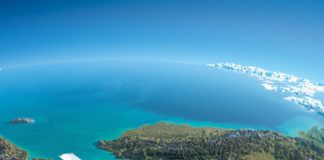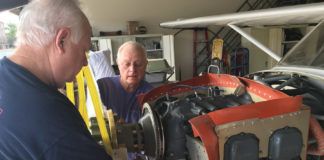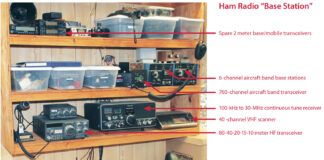Flying at night is something a lot of light aircraft pilots want to do. Weight-shift-control flexwings, powered parachutes and powered paragliders in particular are often primarily sightseers, so it makes sense that pilots would want to get a taste of what things look like after the sun goes down.
What we’ll talk about here are the rules as they pertain to ultralight pilots, Light Sport Aircraft pilots (both of whom can’t fly at night at all) and Private Pilots. One of the main benefits of having a Private Pilot rating for LSA is that you can fly after dark as long as your aircraft is equipped properly. We’ll talk about that, too.

Before you start thinking about night flight, you need to make sure that your cockpit is sporting the right instrumentation.
The Ultralight Rules
Before the Sport Pilot rules were put into place, doing a legal night flight was a particularly tough thing to accomplish in a powered parachute or flexwing trike. If you wanted to fly after dark, you would have to either get an official FAA waiver to do it (Good luck with that!) or get a Private Pilot license (normally for airplanes) and N-number your aircraft. That wasn’t commonly done before 2004.
That’s because the ultralight rules specifically tell you that you can only fly an ultralight between sunrise and sunset. If you want to go past the setting sun—or fly before sunrise—you get an extra half hour of air time if you meet the following requirements:
(1) The vehicle is equipped with an operating anticollision light visible for at least 3 statute miles; and
(2) All operations are conducted in uncontrolled airspace.
The anticollision light requirement is apparent, though I’ve seen some pretty weak anticollision lights. Still, having an anticollision light is important, and not just because it’s a rule. That rule is there because of safety. As the big light in the sky dips past the horizon, things get a lot more difficult to see; especially ultralights. A proper strobe light allows people to see you from 3 statute miles away. That is a long distance for slow movers. In powered parachutes, for example, that equates to 6 minutes or so, of travel time. That time is halved if two powered parachutes are on a collision course. It gets even more important if you are flying anywhere near an airport and dealing with aircraft going 100 mph or more. That is less than 2 minutes for someone to locate you and avoid you—that is, unless you are heading straight on a collision course. Then the math works out to something like 90 seconds. Faster aircraft? Even less time to see and avoid.
The other half of the rule is violated all the time. That’s the provision that ultralight flights after sunset are supposed to take place in uncontrolled airspace. In reality, most of the airspace around us is controlled airspace. For example, virtually all of the airspace 1200 feet above ground level (AGL) is Class E airspace. As you get closer to most public airports, the floor lowers to 700 feet. That is often more than enough altitude to work with, but ultralight pilots who climb high after sunset to enjoy a long glide to the ground are busting regulations, even if they are using a strobe light, and even if they don’t know it.

Wingtip lighting can include both strobe and navigation lights. Here, the navigation lighting is LED. In newer lights, even the strobe is LED.
Sport Pilot Rules
Sport Pilots really don’t get a much better deal than ultralight pilots. They don’t get to fly past civil twilight in the evenings or before it in the mornings. What is civil twilight? It is the time after the sun sets but before it gets dark. It is roughly one half hour after sunset or before sunrise. I find it handy to go to a site like weatherunderground.com and get the local forecast and twilight times in the astronomy section. If you have a smartphone, you can get the information instantly with a free app like Sunrise & Set Lite.
Why Fly at Night?
The first reason for gearing up to fly at night is to stay safe and legal. Powered parachutes and other light aircraft are best enjoyed early in the morning and late in the afternoon, when the winds are normally lightest. However, those calm evenings can quickly turn into tense nights if you are on a cross country or just wander a little too far from where you took off and start running out of daylight. Having the confidence of the appropriate training and certifications to fly at night can take a lot of anxiety out of the impending darkness. It certainly doesn’t solve fuel or headwind problems, but the actual night flight doesn’t have to be something to worry about.
It is also calmer at night than it is during the day. If you like evening flying and there is a full moon or plenty of ground lighting to illuminate stuff, it can be fun.
And of course there are the bragging points. While nearly everyone flying an airplane as a Private Pilot has flown at night, few people have legally taken to the skies under canopy or flexwing. The Private rating for powered parachutes or flexwing trikes puts you into an elite group of pilots. But that elite status, unfortunately, comes mostly from the difficulty in getting the rating. Few people are able to offer dual training, and even fewer designated examiners are able to provide the practical tests. For flexwings and powered parachutes, the numbers are 10 and three, respectively.
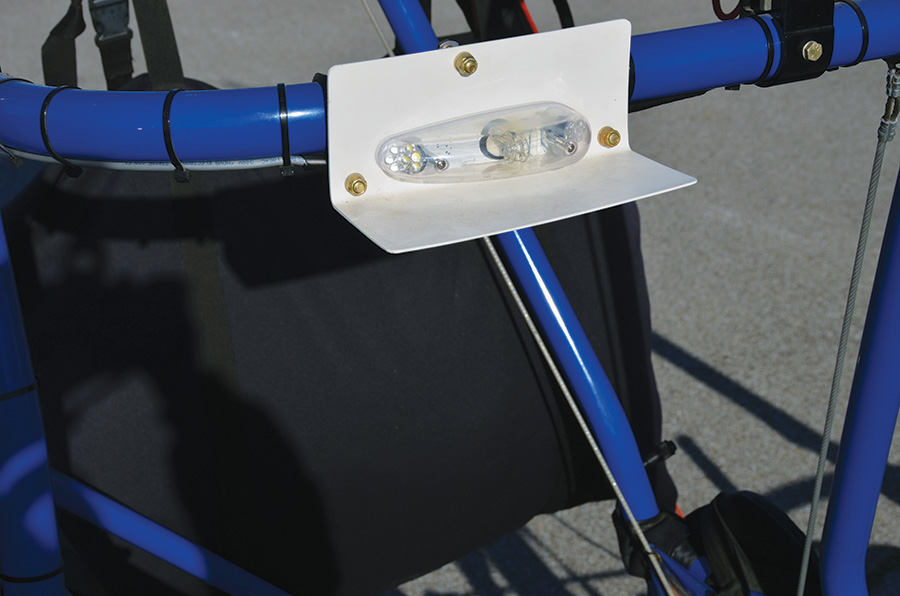
Wingtip lighting on a powered parachute, a trike or a gyroplane can end up putting as much light in the pilot’s eyes as it puts out for others. That is, unless you fashion some kind of screen out of angle stock to mount the light on.
Pilot Credentials
Even though night flying for powered parachutes and flexwing trikes was introduced with the Sport Pilot rules, night flying is not a Sport Pilot privilege. It just goes to show how big a regulation change the Sport Pilot rule was, because along with Sport Pilot ratings and flight-instructor ratings for powered parachutes and flexwings, it also introduced Private Pilot ratings for those two then-brand-spanking-new aircraft categories. The higher rating came with more requirements and more privileges, night flying being the one privilege that is important to us today.
To fly at night, you must have the proper credentials: a third-class medical and a Private Pilot rating for the category you want to fly in, such as airplane, weight-shift-control trike, gyroplane or powered parachute. There are a few loopholes that can be exploited if you hold a Private rating that is not in the category you want to fly in. Those loopholes don’t apply if you want to be able to take a passenger with you. And the loopholes are often closed off depending on what the operating limitations of your aircraft happen to say.
The process for getting a Private Pilot rating is not that much different from getting an initial Sport Pilot rating for most aircraft. With powered parachutes and trikes, it is even easier because no instrument time is required. It does entail some additional dual training, but not necessarily a lot of additional dual training. What I mean is that, as with the Sport Pilot rating for powered parachutes, for example, you need to receive at least 10 hours of dual instruction in a powered parachute from a certified flight instructor to meet the requirements for the rating. However, there are additional things that need to be covered in those 10 hours, including a longer cross-country flight, operations at a control tower and, of course, 3 hours of night training.
Another big difference is in the total number of hours needed to become a Private Pilot for any category. For Sport Pilot, you need a minimum of 12 hours, including your dual time with an instructor. For a Private Pilot rating, you need 25 hours. The good news is that if you are transitioning from Sport Pilot to Private, all of the time you have been flying as a Sport Pilot counts toward the hours for your Private rating. The problem still is with the expensive time, the dual training.
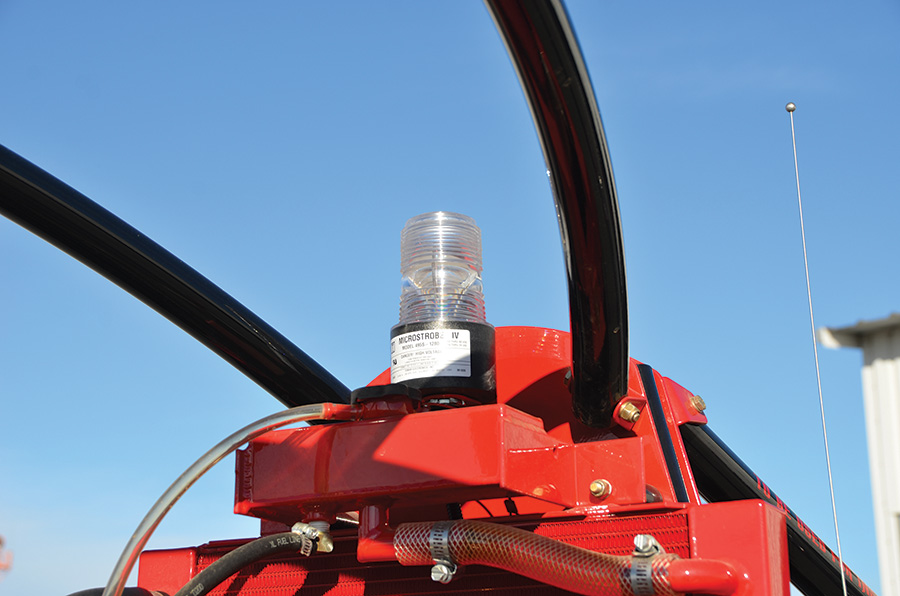
This simple strobe light is perfect for ultralight aircraft. It meets the requirements of Part 103 for flying one half hour before sunrise and one half hour after sunset, some of the best flying times.
Instructor Credentials
The problem with dual time received by a Sport Pilot instructor is that it normally doesn’t count for higher ratings. Here we really are talking a regulatory quirk, and a frustrating one at that. It also explains why many Sport Pilots are frustrated when they start to explore the requirements to earn that Private rating. What all of this means is that the time you spent with your FAA-certified flight instructor learning to fly powered parachutes may or may not count toward a Private rating. It all depends on your instructor’s qualifications. If your instructor holds a Private Pilot rating for powered parachutes or weight-shift-control trikes, your time is good. If your instructor only holds a Sport Pilot privilege for powered parachutes or trikes, then the time doesn’t count. Well, that is unless your instructor has a Private Pilot rating for single-engine land airplanes and an exemption letter from the FAA showing that the powered-parachute training time can count toward the Private rating. If you are working on your Private rating in airplanes, none of your Sport Pilot dual time counts. Confused? You aren’t alone. Hopefully it will be corrected someday. After all, I have noticed that the training provided by CFIs doesn’t seem to change that much according to whether they hold a Sport Pilot rating or a Private Pilot rating. But that is the way some old language in the regulations reads, and that is what we are working under.
OK, so you have read the paragraph above and you are really confused. Don’t be. Ask your instructor if the time counts toward a Private rating. He or she should know. If you get a yes, you are in good shape. A no means that you are going to have to do some more work than you might have guessed.
Unfortunately, more work means starting over. But don’t feel lonely; pilots who already have a Private Pilot rating in other categories, such as airplanes transitioning to powered parachutes, have to start at nearly the same place. That’s the bad news. The good news is that if you are making the transition from Sport Pilot to Private, it is a lot easier to gather that dual time because you won’t need as many separate sessions. You can fly a lot longer, because, well, you already know how to fly. Also, you get to fly at night. That means that the dual training can be compacted into even a shorter period because there is more calm air at night than there is during the day.
Those of you who have been flying airplanes for years as Private Pilots may think you get some kind of big break for the night flying when transitioning to trikes or powered parachutes. Well, yes and no.
If you want to take others along, you get to go through the same training as those getting their first rating. None of your airplane dual time applies. Sorry. As a consolation prize, at least you don’t have to take the Private Pilot knowledge test for powered parachutes. The one you took years ago for single-engine land airplanes works just fine, as long as you actually finished and got your Private rating.
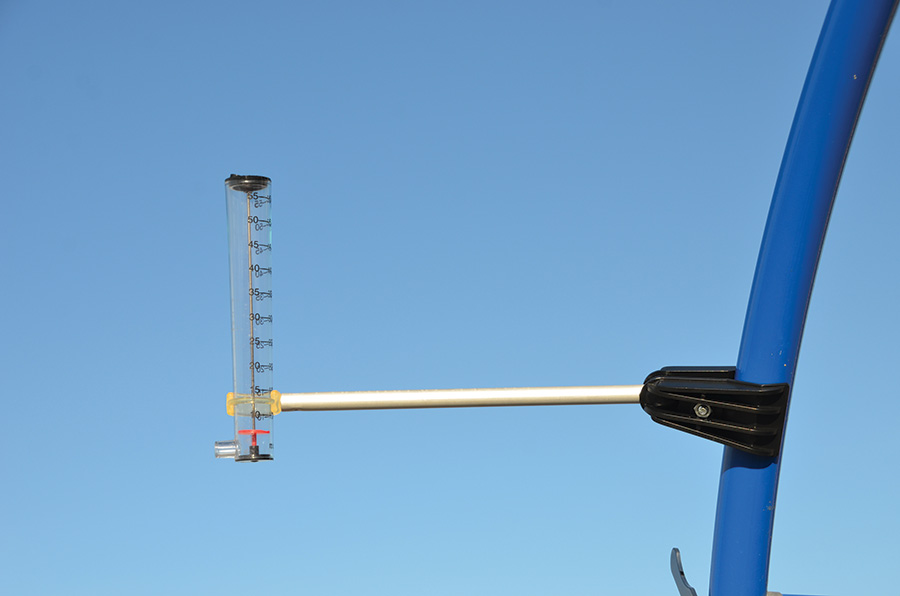
Airspeed indicator on a powered parachute? Well, yes, if you want to fly at night. It doesn’t have to be expensive though. This Halls gauge works just fine.
Equipment
This brings us to your aircraft. Many of the light aircraft we fly are certified as Experimental Light Sport Aircraft (ELSA), Experimental/Amateur-Built (E/AB), Special Light Sport Aircraft (SLSA) or Experimental Exhibition. All of them come with operating limitations. The operating limitations are important because they detail how the aircraft has to be equipped for night flight.
How an aircraft is equipped isn’t something most pilots think much about. After all, the aircraft is equipped the way it came from the factory, and it must have passed muster at some point because it now has an airworthiness certificate. It is hard to argue with that, and generally that is true. For daylight VFR (Visual Flight Rules) operations, there really isn’t any required equipment on Experimental aircraft in general.
But most Experimental aircraft operating limitations will require that the aircraft be equipped a certain way if it is to be flown at night. For many, this means lighting. But there is a little more to it. Let’s take as an example the pertinent operating limitation from an example ELSA:
(11) After completion of Phase I flight testing, unless appropri- ately equipped for night and/or instrument flight in accordance with 14 CFR § 91.205, this aircraft is to be operated under VFR day only.
The little detail is §91.205. It provides a list of equipment that you need for night flight. There you will find:
§91.205(c) Visual Flight Rules (night). For VFR flight at night, the following instruments and equipment are required:
(1) Instruments and equipment specified in paragraph (b) of this section.
(2) Approved position lights.
(3) An approved aviation red or aviation white anticollision light system on all U.S.-registered civil aircraft. Anticollision light systems initially installed after August 11, 1971, on aircraft for which a type certificate was issued or applied for before August 11, 1971, must at least meet the anticollision light standards of part 23, 25, 27, or 29 of this chapter, as applicable, that were in effect on August 10, 1971, except that the color may be either aviation red or aviation white. In the event of failure of any light of the anticollision light system, operations with the aircraft may be continued to a stop where repairs or replacement can be made.
(4) If the aircraft is operated for hire, one electric landing light.
(5) An adequate source of electrical energy for all installed electrical and radio equipment.
(6) One spare set of fuses, or three spare fuses of each kind required, that are accessible to the pilot in flight.
That is where everyone figures out that there is a lighting requirement. However, the rub with the list is that it is paragraph c, and the first item is that you need to have all of the instruments and equipment specified in paragraph b. And what is paragraph b? Paragraph b is a paragraph that we can normally ignore with Experimental and Light Sport Aircraft as long as we are flying day VFR. But since we want to fly at night, we now have to take a closer look. What you see there is:
§91.205(b) Visual Flight Rules (day). For VFR flight during the day, the following instruments and equipment are required:
(1) Airspeed indicator.
(2) Altimeter.
(3) Magnetic direction indicator.
(4) Tachometer for each engine.
(5) Oil pressure gauge for each engine using pressure system.
(6) Temperature gauge for each liquid- cooled engine.
(7) Oil temperature gauge for each air-cooled engine.
(8) Manifold pressure gauge for each altitude engine.
(9) Fuel gauge indicating the quantity of fuel in each tank.
(10) Landing gear position indicator, if the aircraft has a retractable landing gear.
(11) For small civil airplanes certificated after March 11, 1996, in accordance with part 23 of this chapter, an approved aviation red or aviation white anticollision light system. In the event of failure of any light of the anticollision light system, operation of the aircraft may continue to a location where repairs or replacement can be made.
(12) If the aircraft is operated for hire over water and beyond power-off gliding distance from shore, approved flotation gear readily available to each occupant and, unless the aircraft is operating under part 121 of this subchapter, at least one pyrotechnic signaling device. As used in this section, “shore” means that area of the land adjacent to the water, which is above the high water mark and excludes land areas which are intermittently under water.
(13) An approved safety belt with an approved metal-to-metal latching device for each occupant 2 years of age or older.
(14) For small civil airplanes manufac- tured after July 18, 1978, an approved shoulder harness for each front seat. The shoulder harness must be designed to protect the occupant from serious head injury when the occupant experiences the ultimate inertia forces specified in Sec. 23.561(b)(2) of this chapter. Each shoulder harness installed at a flight crewmember station must permit the crewmember, when seated and with the safety belt and shoulder harness fastened, to perform all functions necessary for flight operations. For purposes of this paragraph—
(i) The date of manufacture of an airplane is the date the inspection acceptance records reflect that the airplane is complete and meets the FAA- approved type design data; and
(ii) A front seat is a seat located at a flight crewmember station or any seat located alongside such a seat.
(15) An emergency locator transmitter, if required by Sec. 91.207.
(16) For normal, utility, and acrobatic category airplanes with a seating configuration, excluding pilot seats, of 9 or less, manufactured after December 12, 1986, a shoulder harness for—
(i) Each front seat that meets the requirements of Sec. 23.785 (g) and (h) of this chapter in effect on December 12, 1985;
(ii) Each additional seat that meets the requirements of Sec. 23.785(g) of this chapter in effect on December 12, 1985.
(17) For rotorcraft manufactured after September 16, 1992, a shoulder harness for each seat that meets the requirements of Sec. 27.2 or Sec. 29.2 of this chapter in effect on September 16, 1991.
The list is longer and scarier at first glance than it will be after you study it. Most of the requirements are already made or simply don’t apply, but there are some tricky ones.
Airspeed Indicator
Who needs an airspeed indicator on a powered parachute? Well, you do if you want to fly at night. But you don’t have to spend over $100 for an airspeed indicator that is as useful on a powered parachute as a trap door on a lifeboat. For less than $30, you can get a clamp-on Halls ASI like our friends in hang gliding use. It is cheap, simple and hard to break, and you can remove it when you aren’t flying.
Magnetic Direction Indicator
This requirement can be solved with a cheap compass from the drugstore and some Velcro. Or you can just designate your GPS as a direction indicator. You can also use the built-in app on your iPhone. But you must have this.
Growing Popularity
Slowly people are beginning to look toward their next big aviation challenge. For those who don’t mind getting a third-class medical and going through some extra training, getting night qualified is a good next thing to do. And in a way, I suspect that everyone who pursues the Private rating in powered parachutes or flexwing trikes is doing those sports a favor.
Perhaps if enough people pursue the Private ratings, it will help justify a demand for commercial ratings. That will help move the industry forward and introduce new people to aviation.

![]()
Roy Beisswenger is the technical editor for Powered Sport Flying magazine (www.psfmagazine.com) and host of the Powered Sport Flying Radio Show (www.psfradio.com). He is also a Light Sport repairman and gold seal flight instructor for Light Sport Aircraft as well as the United States delegate to CIMA, the committee of the Fédération Aéronautique Internationale (FAI) pertaining to microlight activity around the world.


